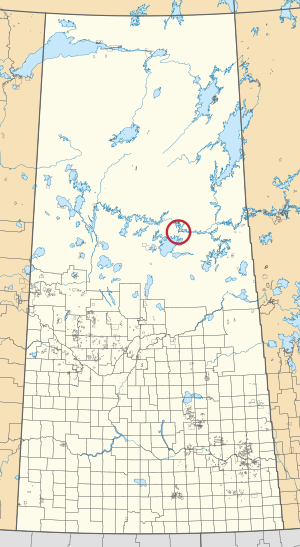Stanley 157 facts for kids
Quick facts for kids
Stanley 157
|
|
|---|---|
| Stanley Indian Reserve No. 157 | |

Location in Saskatchewan
|
|
| First Nation | Lac La Ronge Indian Band |
| Country | Canada |
| Province | Saskatchewan |
| Area | |
| • Total | 251.3 ha (621.0 acre) |
| Population
(2016)
|
|
| • Total | 1,840 |
| Community Well-Being Index | 52 |
Stanley 157 is a special area of land called an Indian reserve. It belongs to the Lac La Ronge Indian Band, a First Nation group in Saskatchewan, Canada. This reserve is located about 56 kilometers northeast of a town called Lac la Ronge.
In 2016, a census counted 1840 people living here. They lived in 451 homes out of 466 total houses. In the same year, Stanley 157's Community Well-Being Index was 52 out of 100. This score helps us understand how well a community is doing.
Contents
Understanding Stanley 157: A First Nation Reserve
Stanley 157 is an official "Indian reserve" in Canada. These reserves are lands set aside for the use and benefit of First Nations peoples. They are managed by the First Nations themselves.
Location of Stanley 157 in Saskatchewan
Stanley 157 is located in the Canadian province of Saskatchewan. It is found in the northern part of the province. The reserve is about 56 kilometers (about 35 miles) northeast of the town of Lac la Ronge. This area is known for its many lakes and forests.
Who Lives in Stanley 157? Population Details
According to the 2016 Canadian Census, 1840 people live in Stanley 157. This makes it a lively community. The census also showed that there were 451 homes where people lived. This means many families and individuals call Stanley 157 their home.
The Lac La Ronge Indian Band: A Brief Look
Stanley 157 is part of the Lac La Ronge Indian Band. This is one of the largest First Nations in Saskatchewan. The band has several reserves, and Stanley 157 is one of them. The Lac La Ronge Indian Band works to support its members. They also work to preserve their culture and traditions.
Community Well-Being Index: What Does It Mean?
The Community Well-Being Index (CWB) is a way to measure how well a community is doing. It looks at things like education, jobs, income, and housing. The index is scored out of 100. A higher score means the community is doing better in these areas.
Stanley 157's Well-Being Score
In 2016, Stanley 157 had a CWB score of 52. This was compared to an average of 58.4 for other First Nations communities. It was also compared to 77.5 for the average non-Indigenous community in Canada. These numbers help us understand the different challenges and strengths of communities.

